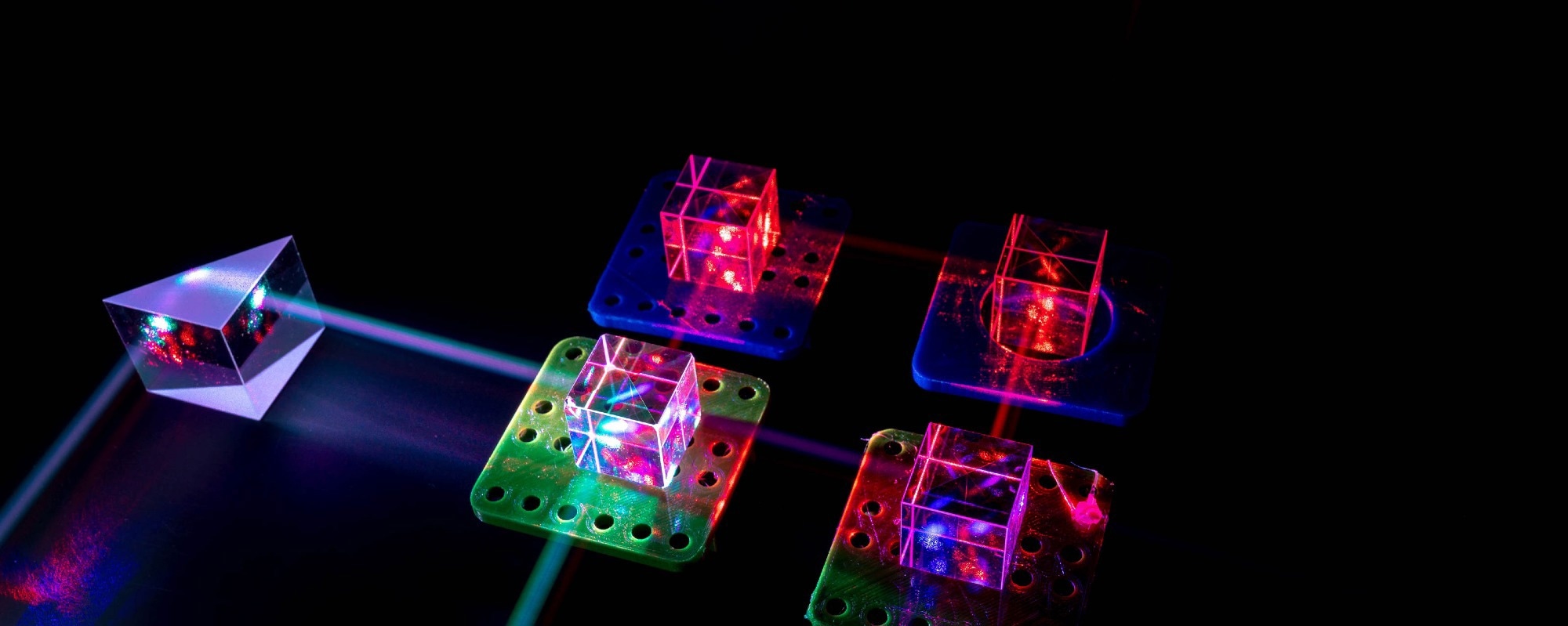 By Owais AliReviewed by Lexie CornerUpdated on Aug 22 2024
By Owais AliReviewed by Lexie CornerUpdated on Aug 22 2024Quantum optics explores the behavior of light and its interactions with matter at the quantum level, focusing on phenomena like quantum entanglement and superposition.

Image Credit: luchschenF/Shutterstock.com
This article highlights recent and significant advancements in quantum optics research, covering breakthroughs in quantum computing, communication, and ultra-precise sensors. These developments underscore the field's rapid progress and its profound implications for both research and practical applications.
Recent Breakthroughs in Quantum Computing
One of the most exciting advancements in quantum optics is quantum computing. Unlike traditional computers that use bits to represent binary states (0 and 1), quantum computers use qubits, which can represent both states simultaneously due to superposition.
Furthermore, qubits can become entangled, linking their states and enabling quantum computers to solve complex problems much faster than the most powerful supercomputers.1
Room-Temperature Quantum Coherence
A significant challenge has been creating qubits that maintain their delicate quantum states at room temperature, traditionally requiring extreme cooling near absolute zero.
However, a team of Japanese researchers recently engineered a stable qubit using metal-organic frameworks with pentacene molecules, achieving quantum coherence for over 100 nanoseconds at room temperature. This innovation reduces the need for costly and complex cryogenic cooling, making room-temperature quantum computing more feasible.2
This can open doors to room-temperature molecular quantum computing based on multiple quantum gate control and quantum sensing of various target compounds.
Associate Professor Nobuhiro Yanai, Lead Researcher of the Study
Atomically Thin Terahertz Transducers for Room-Temperature Quantum Computing
Yoseob Yoon from Northeastern University has developed a method to create atomically thin transducers capable of operating at terahertz frequencies. This advancement could enable quantum computers to function at room temperature by improving the frequency range of quantum transducers, thus overcoming one of the major challenges of quantum computing.3
Scalable Quantum Computing
Researchers have also made progress in increasing the number and quality of qubits. A team from the University of Manchester and the University of Melbourne have developed an enhanced form of ultra-pure silicon, free from silicon-29 impurities that cause qubit instability. This provides a pathway to scalable quantum computing by enabling the creation of up to one million qubits on a pinhead-sized chip.4
Now that we can produce extremely pure silicon-28, our next step will be to demonstrate that we can sustain quantum coherence for many qubits simultaneously. A reliable quantum computer with just 30 qubits would exceed the power of today's supercomputers for some applications.
Professor David Jamieson, Project Co-Supervisor
Innovations in Quantum Communication and Cryptography
Quantum communication and cryptography offer a new level of secure communication by leveraging quantum physics. Unlike traditional methods that rely on mathematical encryption, quantum cryptography detects eavesdropping through the physical properties of qubits.
Any tampering causes the qubits' state to collapse, revealing interference. This ensures that only secure keys are used for data transmission, making quantum communication a highly secure method for transmitting sensitive information.5
Researchers are making significant advancements to further improve the security and practicality of quantum communication and cryptography.
Quantum Device Connectivity
Researchers at the Kastler Brossel Laboratory have developed a novel converter that facilitates communication between quantum information encodings. The converter leverages quantum entanglement to switch between different quantum information encodings while preserving the fragile quantum-coded information signal.
This breakthrough could enable interoperability among diverse quantum devices, marking a key step toward establishing a functional quantum internet.6
Secure Quantum Cloud Computing
In another critical development, scientists at Oxford University Physics developed a technique called "blind quantum computing" that allows users to access remote quantum computers to process confidential data. This method uses a fiber network link between a simple photon-detecting device and a quantum computing server, enabling verification of results without revealing sensitive information.7
As quantum computers become more capable, people will seek to use them with complete security and privacy over networks, and our new results mark a step change in capability in this respect.
Professor David Lucas, Lead scientist at the UK Quantum Computing and Simulation Hub
Enhanced Random Number Generation for Advance Cryptography
A study published in PRX quantum designed a random number generator that utilizes quantum fluctuations (the behavior of particle-antiparticle pairs forming and self-destructing) to generate truly random numbers. This system can generate random numbers up to 200 times faster than conventional systems, potentially enhancing cryptographic security.8
Advances in Quantum Sensors and Measurement Techniques
Quantum sensing and metrology have surpassed classical methods by overcoming limitations such as shot (electronic) noise, the standard quantum limit, and the diffraction limit, enabling unprecedented atomic-scale precision and imaging.
Researchers are continuously advancing these technologies, enhancing their real-time applications and performance.9
Enhanced Control of Quantum Defects for Improved Quantum Sensing
MIT researchers have developed a technique to better control microscopic defects in diamonds, known as dark spins, which serve as qubits for quantum sensing. By improving the control of these qubits, researchers could boost the sensitivity of quantum sensors, enabling more precise measurements in fields such as brain imaging and air traffic control.10
Neuromorphic Vision Sensors
A study published in Advanced Science has introduced a neuromorphic vision sensor that improves the resolution and speed of widefield quantum sensing. These sensors, designed to mimic the human vision system, encode changes in fluorescence intensity into spikes during optically detected magnetic resonance (ODMR) measurements.
This approach resulted in a 13-fold improvement in temporal resolution compared to traditional methods, with potential applications in monitoring dynamic processes in biological systems and materials science.11
Emerging Applications in Various Industries
Astronomical Imaging
Quantum technology is revolutionizing astronomical imaging by developing high-resolution, long-baseline optical interferometers. Researchers at Macquarie University and the National University of Singapore have proposed using quantum error correction to protect fragile captured starlight from environmental noise.
This technique could significantly enhance image resolution by enabling telescopes to be placed farther apart, potentially surpassing the diffraction limit. It is particularly promising because it can tolerate error rates of up to 50 % using simple repetition codes, making it viable for near-term quantum devices.12
Atomic-Scale Sensing
Quantum sensors are also making significant strides in materials science and nanotechnology. An international collaboration of Korea's IBS Center for Quantum Nanoscience and Germany's Forschungszentrum Jülich research team has designed a quantum sensor capable of detecting minute magnetic fields at the atomic scale.
This breakthrough realizes the long-held dream of an MRI-like tool for quantum materials, with potential applications in designing new catalysts, engineering quantum materials, and exploring fundamental quantum behavior in molecular systems, including biochemistry.13
What makes this achievement so striking is that we use an exquisitely engineered quantum object to resolve fundamental atomic properties from the bottom up. Preceding techniques for visualizing materials use large, bulky probes to try to analyze tiny atomic features.
Dr. Dimitry Borodin, Lead Author of the Study
Conclusion
These recent breakthroughs highlight the transformative potential of quantum optic technology across diverse industries, including astronomy, particle physics, materials science, and medicine.
As these technologies evolve, they are set to unlock new capabilities and foster innovation, impacting both fundamental scientific research and practical, real-world applications.
More from AZoOptics: What is Optical Data Storage?
References and Further Reading
- Stackpole, B. (2024). Quantum computing: What leaders need to know now. [Online] The MIT Sloan School of Management. Available at: https://mitsloan.mit.edu/ideas-made-to-matter/quantum-computing-what-leaders-need-to-know-now
- Yamauchi, A., et al. (2024). Room-temperature quantum coherence of entangled multiexcitons in a metal-organic framework. Science Advances. doi.org/10.1126/sciadv.adi3147
- Yoon, Y., et al. (2024). Terahertz phonon engineering with van der Waals heterostructures. Nature. doi.org/10.1038/s41586-024-07604-9
- Acharya, R., et al. (2024). 28Si enriched silicon by localised focused ion beam implantation. Commun Mater. doi.org/10.1038/s43246-024-00498-0
- Gilesarchive page, M. (2019). What is quantum communication? [Online]. MIT Technology Review. https://www.technologyreview.com/2019/02/14/103409/what-is-quantum-communications/
- Darras, T., et al. (2023). A quantum-bit encoding converter. Nat. Photon. doi.org/10.1038/s41566-022-01117-5
- Drmota, P., et al. (2024). Verifiable blind quantum computing with trapped ions and single photons. Physical Review Letters. doi.org/10.1103/PhysRevLett.132.150604
- Bruynsteen, C., Gehring, T., Lupo, C., Bauwelinck, J., Yin, X. (2023). 100-Gbit/s integrated quantum random number generator based on vacuum fluctuations. PRX quantum. doi.org/10.1103/PRXQuantum.4.010330
- HÜBNER Photonics. (2024). Quantum sensing and metrology. [Online] HÜBNER Photonics. Available at: https://hubner-photonics.com/knowledge-bank/quantum-metrology-and-sensing/
- Ungar, A., Cappellaro, P., Cooper, A., Sun, WKC. (2024). Control of an Environmental Spin Defect beyond the Coherence Limit of a Central Spin. PRX Quantum. doi.org/10.1103/PRXQuantum.5.010321
- Du, Z., et al. (2024). Widefield Diamond Quantum Sensing with Neuromorphic Vision Sensors. Advanced Science. doi.org/10.1002/advs.202304355
- Huang, Z., Brennen, GK., Ouyang, Y. (2022). Imaging stars with quantum error correction. Physical Review Letters. doi.org/10.1103/PhysRevLett.129.210502
- Esat, T., et al. (2024). A quantum sensor for atomic-scale electric and magnetic fields. Nat. Nanotechnol. doi.org/10.1038/s41565-024-01724-z
Disclaimer: The views expressed here are those of the author expressed in their private capacity and do not necessarily represent the views of AZoM.com Limited T/A AZoNetwork the owner and operator of this website. This disclaimer forms part of the Terms and conditions of use of this website.